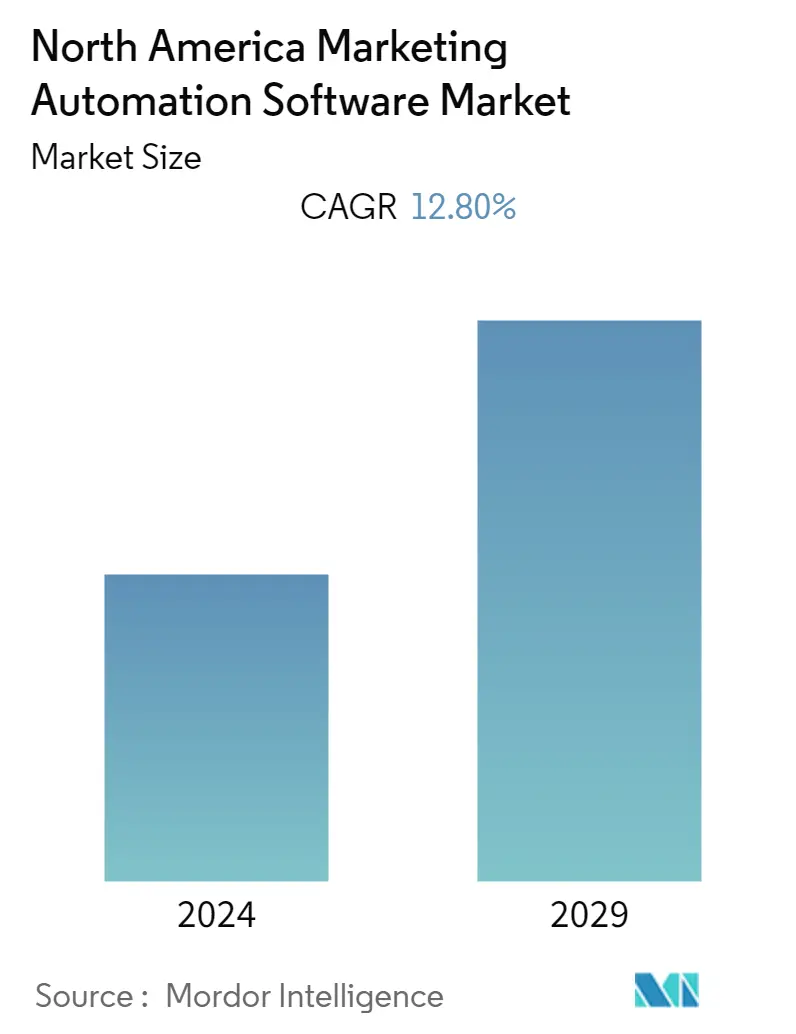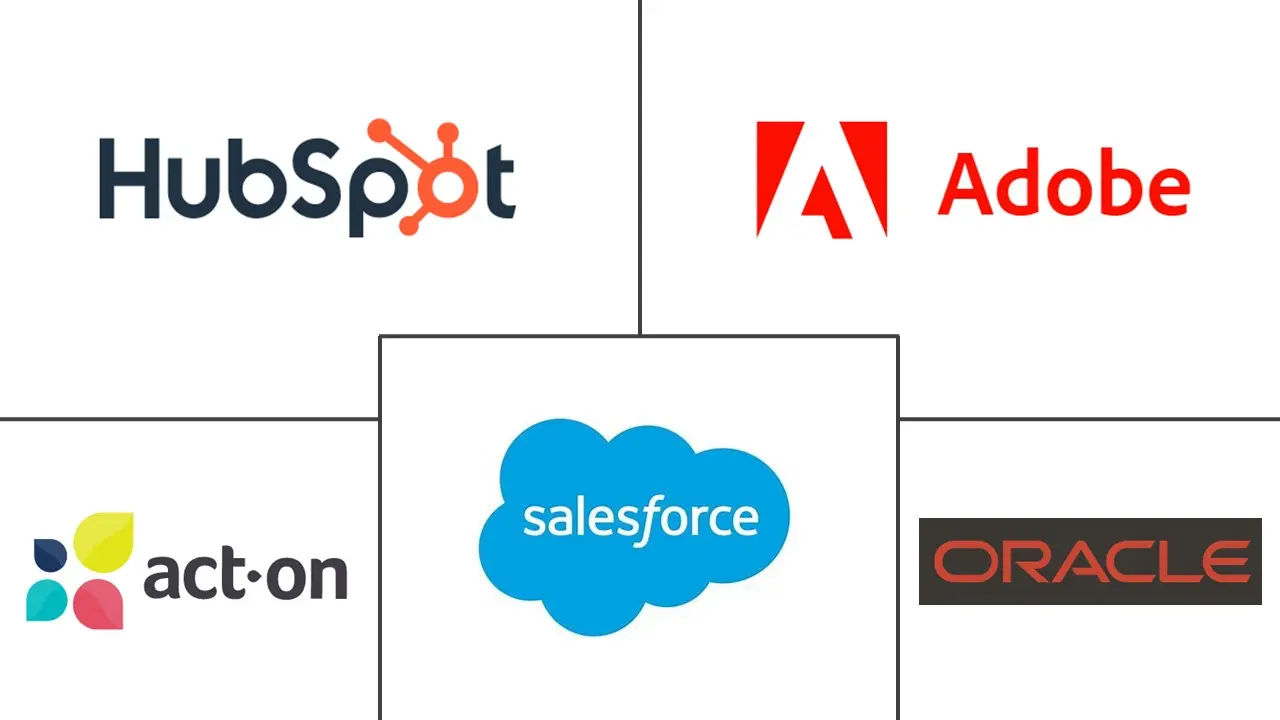Market Size of North America Industrying Automation Software Market

| Study Period | 2019 - 2029 |
| Base Year For Estimation | 2023 |
| Forecast Data Period | 2024 - 2029 |
| Historical Data Period | 2019 - 2022 |
| CAGR | 12.80 % |
| Market Concentration | High |
Major Players
*Disclaimer: Major Players sorted in no particular order |
North America Marketing Automation Software Market Analysis
The North American marketing automation software market is expected to register a CAGR of 12.8% during the forecast period. Growing enterprise demand for a strategic marketing approach focused on creating and distributing valuable and relevant content to attract and engage a specifically defined audience, the increased presence of marketing automation vendors, and growing government support are the major factors driving market growth during the forecast period.
- Marketing automation facilitates the coordination of various sales teams to generate and keep track of leads. The marketing team uses the massive amount of data generated to plan and refine their campaigns. E-commerce websites like eBay and Amazon use products like these to customize their pages based on previous customer visits.
- Additionally, marketing automation software provides marketing teams with various solutions for seamlessly performing repetitive tasks. The rise of social media and the importance of maintaining a digital presence significantly propel the market's growth. The software can be used in email marketing and online advertising campaigns. The increasing use of social media platforms for disseminating information, creating a brand image, and reaching out to followers impacts the market. Increased SaaS usage and significant cloud computing advancements contribute to the market's growth. Marketing automation is a briskly growing subset of the CRM software market.
- Further, incorporating artificial intelligence and machine learning in search engines by using frequently used search phrases and optimizing them for maximum market reach is likely to be a new strategy for large corporations. Predictive analytics can help them meet the changing needs of their customers and focus their spending accordingly. Campaigns can be designed to meet the user's needs to generate leads, improve the customer experience and, in turn, drive the market automation software market.
- However, data privacy and security are critical considerations when implementing digital enablement technologies. As SMAC technologies become more widely used, organizations will require more robust security and privacy safeguards to prevent breaches. The issue of security has an impact on digitalization's success. As the number of customer data sets grows, so will the number of security and privacy issues, and endpoints, gateway, and smartphones can become a likely target for hackers. Data security and privacy are a bottleneck that must be effectively addressed.
- With the onset of the COVID-19 pandemic, many B2B marketing companies adopted a "play it safe" approach through which they reduced their marketing budgets until they could analyze the impact on their businesses and had to wait for the economic scenario to improve. According to a survey by Hubspot, almost half of the businesses implemented a cut of 1%-25% of their marketing budgets. During the pandemic, most B2B marketing companies reported budget cuts of 26%+, but some of the budgets have been restored, resulting in lower overall budgetary cuts due to the pandemic. Expanding focus beyond the traditional top-of-funnel demand generation, migration to digital mediums, and adopting centralized tools that can be used across regional marketing functions are expanding market growth after the pandemic.
North America Marketing Automation Software Industry Segmentation
Marketing automation refers to utilizing software to automate repetitive marketing tasks. Marketers employ this software to help nurture leads, usually through integrations with customer relationship management (CRM) and customer data platform (CDP) software. They also utilize these platforms to automate and personalize marketing messages and content.
The North American marketing automation software market is segmented by deployment (on-premise and cloud), by application (campaign management, social media marketing, digital marketing, e-mail marketing, mobile marketing, inbound marketing, and other applications), by end-user industry (government, advertising, media and entertainment, retail, manufacturing, BFSI, healthcare, and other end-user industries), and by geography (United States, Canada, and Rest of North America).
| By Deployment | |
| On-premise | |
| Cloud |
| By Application | |
| Campaign Management | |
| Social Media Marketing | |
| Digital Marketing | |
| E-mail Marketing | |
| Mobile Marketing | |
| Inbound Marketing | |
| Other Applications |
| By End-user Industry | |
| Government | |
| Advertising | |
| Media and Entertainment | |
| Retail | |
| Manufacturing | |
| BFSI | |
| Healthcare | |
| Other End-user Industries |
| By Geography | |
| United States | |
| Canada | |
| Rest of North America |
North America Marketing Automation Software Market Size Summary
The North American marketing automation software market is experiencing robust growth, driven by the increasing demand for strategic marketing approaches that focus on engaging targeted audiences through valuable content. The proliferation of marketing automation vendors and supportive government initiatives further bolster this expansion. Marketing automation software plays a crucial role in coordinating sales teams, managing leads, and refining campaigns using vast data analytics. The rise of e-commerce and social media has significantly contributed to the market's growth, as businesses leverage these platforms for personalized marketing and brand engagement. The integration of artificial intelligence and machine learning is expected to enhance predictive analytics, allowing companies to tailor campaigns to meet evolving customer needs. However, data privacy and security remain critical challenges, necessitating robust safeguards to protect against potential breaches.
The shift towards digital omnichannel marketing is reshaping the retail landscape in North America, with marketing automation software becoming essential for retailers to adapt to changing consumer behaviors. This software enables automated product recommendations, personalized marketing, and customer engagement strategies, enhancing customer relationships and increasing transaction values. The market is witnessing a decline in traditional advertising spend, with a corresponding rise in digital marketing investments. Major players like HubSpot, Adobe Inc., Oracle Corporation, Salesforce, and Act-on Software dominate the market, leveraging strategic partnerships to expand their reach. Recent collaborations, such as those between HubSpot and ClickUp, and Adobe's enhancements to its Creative Cloud, highlight the ongoing innovation and integration efforts within the industry. These developments underscore the market's trajectory towards more efficient, data-driven marketing solutions.
North America Marketing Automation Software Market Size - Table of Contents
-
1. MARKET INSIGHTS
-
1.1 Market Overview
-
1.2 Industry Attractiveness - Porter's Five Forces Analysis
-
1.2.1 Bargaining Power of Suppliers
-
1.2.2 Bargaining Power of Consumers
-
1.2.3 Threat of New Entrants
-
1.2.4 Threat of Substitute Products
-
1.2.5 Intensity of Competitive Rivalry
-
-
1.3 Assessment of the Impact of COVID-19 on the Market
-
-
2. MARKET SEGMENTATION
-
2.1 By Deployment
-
2.1.1 On-premise
-
2.1.2 Cloud
-
-
2.2 By Application
-
2.2.1 Campaign Management
-
2.2.2 Social Media Marketing
-
2.2.3 Digital Marketing
-
2.2.4 E-mail Marketing
-
2.2.5 Mobile Marketing
-
2.2.6 Inbound Marketing
-
2.2.7 Other Applications
-
-
2.3 By End-user Industry
-
2.3.1 Government
-
2.3.2 Advertising
-
2.3.3 Media and Entertainment
-
2.3.4 Retail
-
2.3.5 Manufacturing
-
2.3.6 BFSI
-
2.3.7 Healthcare
-
2.3.8 Other End-user Industries
-
-
2.4 By Geography
-
2.4.1 United States
-
2.4.2 Canada
-
2.4.3 Rest of North America
-
-
North America Marketing Automation Software Market Size FAQs
What is the current North America Marketing Automation Software Market size?
The North America Marketing Automation Software Market is projected to register a CAGR of 12.80% during the forecast period (2024-2029)
Who are the key players in North America Marketing Automation Software Market?
HubSpot, Adobe Inc., Oracle Corporation, Salesforce and Act-on Software are the major companies operating in the North America Marketing Automation Software Market.

